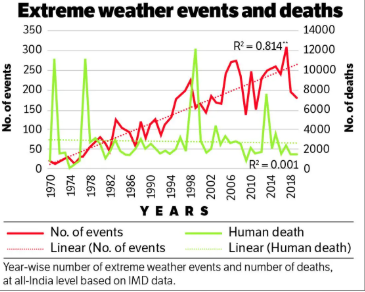India’s Heat-Health Crisis
India’s Heat-Health Crisis
Syllabus
GS 3: Environment
Why in the News?
India is witnessing worsening heat waves, straining its public health systems. Experts at a national climate-health conference called for urgent, preventive, and equity-based reforms to handle rising heat-related illnesses and address the growing heat health crisis.
Introduction
- India is experiencing increasingly severe heat waves that pose a major public health threat, with authorities issuing severe heatwave alerts more frequently.
- From overburdened hospitals to vulnerable workers, the impact of excessive heat is widespread, leading to a range of body heat symptoms.
- There is an urgent need for a climate-resilient health system that is preventive, community-driven, and equitable, integrating science with grassroots action and interdisciplinary collaboration to combat the heat wave in India.
Uniting Unlikely Allies: A New Approach
- At the national conference titled ‘India 2047: Building a Climate-Resilient Future’, diverse voices came together to address the heat health crisis.
- A trade union leader described the daily struggles of garment workers in overheated factories, highlighting the need for heat wave precautions in workplaces.
- A climate modeller explained wet-bulb temperatures, a key scientific measure for understanding heat stress and predicting heatwave conditions.
- This unique mix of real-life experiences and scientific data highlighted how different sectors must collaborate to tackle the heat health crisis.
- It also featured professionals such as paediatricians, maternal health experts, architects, city engineers, policymakers, and academicians working together.
- The conference emphasized that solving the climate-health crisis requires input from all these stakeholders, including experts in urban planning to design heat-resilient cities.
Persistent Heat and Its Health Impact
- India is undergoing longer and harsher heat waves, regardless of when the monsoon sets in, leading to more frequent excessive heat warnings.
- These heatwaves result in public health crises, from dehydration and heat exhaustion to aggravation of chronic diseases and even heat stroke.
- Healthcare systems are being pushed to their limits, struggling to cope with the influx of patients suffering from internal body heat symptoms.
- Unfortunately, India’s current approach is heavily focused on reactive, emergency care, like hospital beds, IV fluids, and emergency services.
- There is minimal focus on proactive, preventive care that could reduce hospital burden and save lives in advance of severe heatwave alerts.
Transition to Preventive, Proactive Healthcare
Primary Healthcare as First Defence
- India’s primary health care system needs to be climate-ready and equipped to handle the heat health crisis.
- Workers at Health and Wellness Centres, Primary Health Centres (PHCs), and ASHA workers are ideally positioned to act as heat-safety champions.
- With proper training, these frontline workers can:
- Warn communities in advance of heatwaves
- Check on elderly and high-risk individuals
- Educate people on hydration and avoiding peak heat hours
- Identify early signs of heat-related illness and body heat symptoms
Role of Technology in Prevention
- Meteorological early warning systems must be linked to local health networks to issue timely heat alerts.
- An ideal scenario would include:
- ASHAs sending heat alert messages to WhatsApp groups
- Door-to-door visits to elderly or sick individuals
- Hydration kits distributed in anticipation of excessive heat warnings
- This model has saved lives in Ahmedabad and can be scaled nationwide, especially in rural areas affected by the heat wave in India.
Managing Chronic Illness During Heatwaves
- People with diabetes, heart disease, kidney ailments, and mental health disorders are especially vulnerable to high heat.
- Doctors must:
- Adjust medication during hot weather
- Educate patients about heat wave precautions
- Monitor vulnerable patients more closely for signs of heat stroke and other heat-related illnesses
- Routine chronic care must include heat protection guidance and awareness of internal body heat symptoms.
Updating Clinical Practice and Hospital Readiness
Need for Better Clinical Protocols
- Many healthcare providers still do not check for heat exposure during general health screenings, despite the increasing frequency of heatwaves.
- Heat exhaustion is often misdiagnosed or completely missed, particularly in emergency rooms.
- There is an urgent need for clear and standardized protocols for diagnosing and treating heat illnesses, including heat stroke and other body heat symptoms.
Hospital Preparedness
- Hospitals should have dedicated “heat corners” in emergency departments to handle cases during severe heatwave alerts.
- They must also:
- Pre-stock cooling kits
- Conduct summer drills to train staff on handling heat health crisis situations
- Provide post-discharge follow-ups for heat illness patients
- These steps make a significant difference and reflect a preventive approach to managing the heat wave in India.
Climate-Health Crisis Requires Cross-Sector Solutions
Health Sector Cannot Act Alone
- Preventing illness is not just about medical care; it’s about reducing exposure to extreme heat.
- This requires action from various sectors:
- Urban planners to design cooler homes and public spaces
- Water departments to ensure sufficient supply during heatwaves
- Labour departments to regulate outdoor work hours and improve working conditions
- Climate scientists to collaborate with health officials for data-driven interventions and heat alerts
Beyond Centres of Excellence
- India should move away from isolated “centres of excellence.”
- Instead, build networks of excellence – multi-disciplinary teams including:
- Climate scientists
- Public health professionals
- Urban planning experts
- Labour rights activists
- Grassroots community leaders
- These teams can co-create solutions like:
- Misting shelters in slums
- Cool roofs in Anganwadi centres
- Local cooling strategies for high-risk areas during heatwaves
Equity: The Foundation of Heat-Health Resilience
Heat as a Social Justice Issue
- Heat waves are not just environmental events, they worsen social inequality and exacerbate the heat health crisis.
- The worst-affected include:
- Street vendors working on scorching pavements
- Children in crowded, non-ventilated classrooms
- Elderly people in tin-roofed homes without fans
- Waste pickers with no shelter
- Daily wagers working under direct sun, often without knowledge of heat wave precautions
“Stay Indoors” is Not a Solution
- Advisories like “stay indoors” don’t help vulnerable people who have no option but to work outside during excessive heat warnings.
- It highlights the systemic inequality and lack of social protection mechanisms in the face of the heat health crisis.
Targeted, Equity-Rooted Public Health Measures
- To reduce heat-related mortality and illness, India must:
- Map social heat vulnerability, not just weather conditions
- Conduct early-morning health checks during red heat alert days
- Provide mobile hydration stations in low-income areas
- Build cool shelters for homeless individuals
- Offer subsidies and policies for outdoor workers’ protection against heatwaves
- These measures align with both scientific recommendations and the moral obligation to protect the most vulnerable from the heat wave in India.
Way Forward: Urgency and Vision
- The time for action is rapidly closing as climate change intensifies heat waves in India.
- As climate extremes become more frequent and intense, the need to adapt and respond to the heat health crisis becomes unavoidable.
- India has a unique opportunity to lead the world by building a heat-resilient public health system that is:
- Equity-focused
- Grounded in science
- Led by local champions
- Embedding heat resilience into healthcare infrastructure now will save lives and ensure sustainable development in the future, particularly in urban planning and public health sectors.
Conclusion
India must act now to combat the growing heat health crisis. Proactive, interdisciplinary, and equity-rooted healthcare strategies will safeguard vulnerable populations and ensure resilience in a warming world. Implementing comprehensive heat action plans that include temperature monitoring, emergency preparedness, and acclimatization strategies is crucial. Delay is no longer an option in the face of this extreme heat wave threat. By integrating heat alerts, improving urban planning, and focusing on heat wave precautions, India can build a more resilient future for all its citizens.
Source : The Hindu
Mains Practice Question
Heat waves are no longer just a weather phenomenon but a public health emergency. Evaluate India’s preparedness and suggest a multi-sectoral action plan to address the effects of heat waves on humans, including measures for heat stroke prevention and management of internal body heat symptoms.






